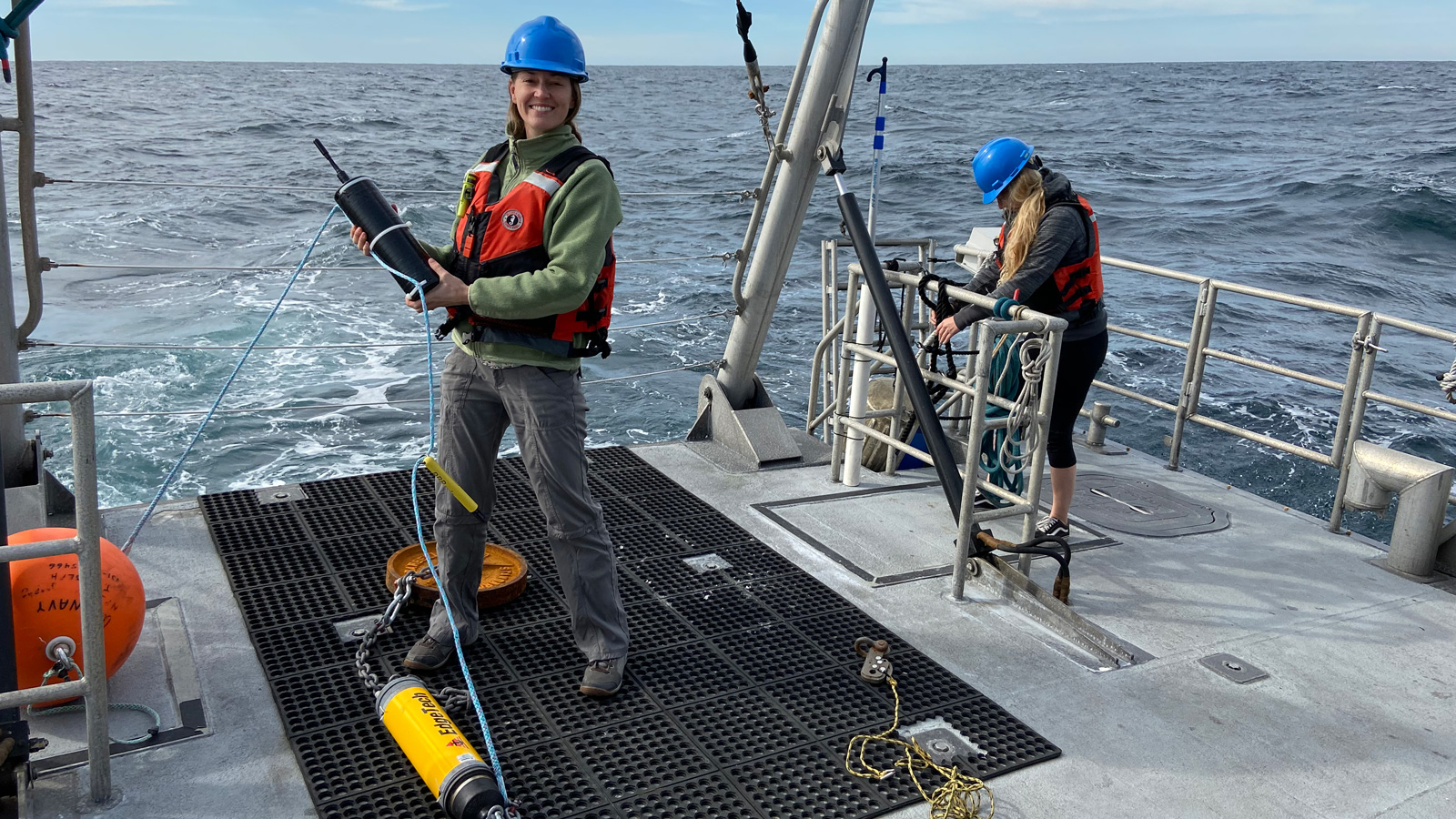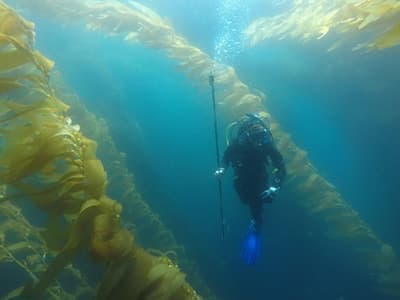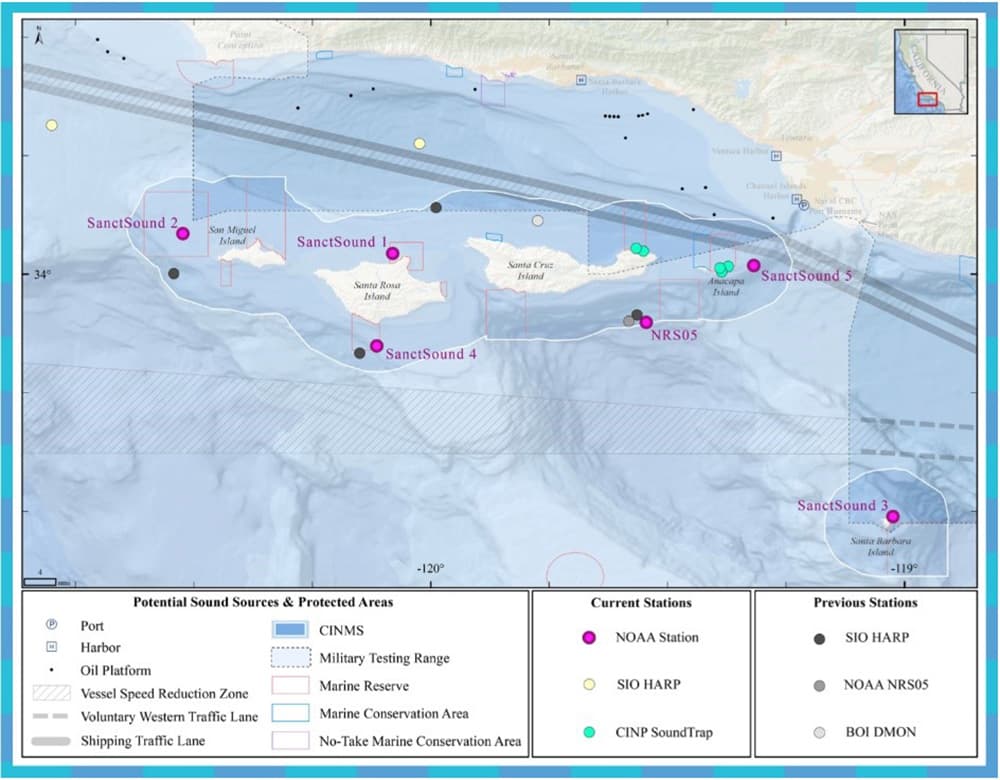Ocean Noise
Conservation Issue

Humans and marine life produce and rely on underwater sound for navigation, locating animals or objects, and sensing the environment. Some examples of noise-producing activities or types of human-made sound that can adversely impact marine life include: vessel noise, sonar and other military activities, construction, oil and gas production, and non-lethal acoustic deterrents used in fisheries. These sources can contribute to creating a noisy acoustic "soundscape" that can intentionally or unintentionally interfere with an animal's ability to use sound, cause changes in animal behavior, or, in some cases, result in injury. Ocean sound research can improve the Office of National Marine Sanctuaries' ability to characterize sanctuary soundscapes and assess impacts on sanctuary resources, particularly for animals (e.g., marine mammals, fish, and invertebrates) that rely on sound to forage, socialize, and navigate.
Description

Research shows that much of the world's ocean has become noisier over the past several decades as the ocean is increasingly used for commerce, food supply, national security, recreation, research, and sense of place. This trend has been observed in Southern California. Depending on bathymetry, extent and variety of sound sources, and climate, certain ocean areas can be consistently quiet, consistently noisy, or variable over time. Soundscapes can be characterized using passive acoustic monitoring (PAM), which records sound within specified frequency bands in consistent stationary locations (mooring based), drifting buoys or along transects (ship/autonomous underwater vehicle [AUV] based). PAM is a powerful research and monitoring approach used to better understand the complex nature of the soundscape by helping to reveal the sources and interactions of sound sources, however the acoustic environment is severely undersampled. There are a number of active and historic data streams available to researchers that are ideal starting points for addressing sanctuary needs for acoustic data to inform resource protection, condition reporting and management planning.
Data and Analysis Needs
- Characterization and monitoring of overall sound levels and variability (e.g. seasonal, diurnal, interannual) at locations of interest in CINMS, including comparisons to other locations and marine protected areas (MPAs)
- Relative contributions to the soundscape from natural (e.g., marine mammals, fishes), environmental (e.g, weather) versus human-made sources (e.g., vessels, seal bombs)
- Relationship between sources of sound and economic covariates (e.g., economic depressions, COVID-19), and management actions (e.g., MPA designations, fishery closures)
- Methods for using the soundscape to monitor aspects of biodiversity and ecosystem health and detecting changes in these characteristics through time
- Acoustic niches of fishes across sanctuary habitats and how they vary over time; comparisons with telemetry monitoring locations and MPA designations
- Baseline vessel noise levels in the sanctuary (validated with vessel activity information from AIS or VMS when possible) and evaluation of potential quieting effects of alternative vessel management strategies, including changes to the Southern California Vessel Speed Reduction program, Area To Be Avoided (ATBA), or Traffic Separation Scheme
- Levels of explosive noise (e.g., seal bombs) and how these vary over space and time; comparisons of patterns in explosive noise between CINMS and Monterey Bay National Marine Sanctuary
- PAM produces large amounts of raw data that require substantial effort to quality control, analyze and archive. Documentation and standardization of data processing, analysis, and product development is essential to support comparison of soundscapes, sound levels, and detections across both space and time.
Potential Products
- Regularly updated, standardized time series of relevant ocean sound metrics for tracking the status and trends of sanctuary habitats, marine life, and human activities, as well as the overall sanctuary soundscape. Standardized time series products support condition reports, Integrated Ecosystem Assessments, and NOAA's efforts to use sound as an Essential Ocean Variable
- Report on the effectiveness of sound monitoring to characterize temporal and spatial patterns in local abundance and connectivity patterns for sound-producing species, especially for evaluating MPA efficacy and other management strategies
- Report on the potential quieting effects of alternative vessel management strategies including maps of areas in need of noise mitigation efforts and recommended management activities
- Report summarizing spatial and temporal patterns in other human activities of interest such as seal bombs usage and smaller boat traffic in sensitive areas
- Report summarizing changes in the sanctuary soundscape resulting from global and regional economic events that alter ocean use patterns (e.g., COVID-19, economic depression)
- Library of example audio files of sound sources in CINMS for use in education and outreach programs and products

For more information about this assessment, contact research.CINMS@noaa.gov

